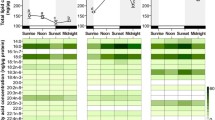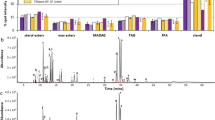Abstract
The symbiotic sea anemone Condylactis gigantea does not make a CaCO3 skeleton, yet its lipid metabolism appears to be very similar to that of reef-building corals. Like hermatypic corals, it is roughly 1/3 lipid on a dry weight basis, its lipid is composed primarily of saturated wax ester and triglyceride, and in the light, its symbiotic algae (zooxanthellae) are the major sites of lipid synthesis in the intact association. Lipid droplets isolated from host tentacle tissue, where the majority of zooxanthellae also occur, contained primarily wax ester and triglyceride in an apparently supercooled liquid state. The diameter of the extra-algal droplets, 3.4±0.7 μm, was similar to that of droplets observed to protrude from isolated zooxanthellae. When anemones were allowed to assimilate acetate-1-14C in the light, only the zooxanthellae and tentacle lipid droplets incorporated significant radioactivity. In the corresponding dark incubations the lipid droplets showed the highest specific activity (5.0 pmol acetate-1-14C/mg lipid). With photic exposure, extra-algal droplet specific activity increased 60% and the zooxanthellae specific activity increased from a dark value of 1.0 to 20.0 pmol acetate-1-14C/mg lipid in the light. A scheme is presented to suggest how carbon may be fixed into lipids by the algae. In C. gigantea, 97% of the total lipid is stored in the polyp column, which is connected to the tentacles by the gastrovascular cavity. In the tentacle tissue, lipid droplets were often found to be inside vesicles; however, upon tentacle contraction free droplets accumulated in the tentacle lumen. Thus, lipid synthesized in the tentacle may be transported to coelenterate tissues via the circulating internal fluid in the form of lipid droplets.
Similar content being viewed by others
Literature cited
Benson, A. A. and C. Muscatine: Wax in coral mucus: energy transfer from corals to reef fishes. Limnol. Oceanogr. 19, 810–814 (1974)
Benson, A. A., J. S. Patton and S. Abraham: Energy exchange in coral reef ecosystems. Atoll Research Bull no. 220 Coral reef ecosystems: Proceedings of papers presented at the 13th Pacific Science Congress, Vancouver. Edited by S. V. Smith. Issued by the Smithsonian Institution. Washington, DC 1978
Bergmann, W., S. M. Creighton and W. M. Stokes: Contributions to the study of marine products. XL. Waxes and triglycerides of sea anemones. J. Org. Chem. 21, 721–728 (1956)
Blanquet, R. S., J. C. Nevenzel and A. A. Benson: Acetate incorporation into the lipids of the anemone Anthopleura elegantissima and its associated zooxanthellac. Mar. Biol. 54, 185–194 (1979)
Bligh, E. G. and W. J. Dyer: A rapid method of total lipid extraction and purification. Can. J. Biochem. Physiol. 37, 911–917 (1959)
Browse, J., G. Roughan and C. R. Slack: Light control of fatty acid synthesis and diurnal fluctuations of fatty acid composition in leaves. Biochem. J. 196, 347–354 (1981)
Chrispeels, M. J.: The endoplasmic reticulum. In: The biochemistry of plants, Vol. 1, pp 405–408. Ed. by N. E. Tolbert, New York: Academic Press (1980)
Crossland, C. J., D. J. Barnes and M. A. Borowitzka: Diurnal lipid and mucus production of the staghorn coral Acropora acuminata. Mar. Biol. 60, 81–90 (1980)
Crumeyrolles-Duclaux, G.: First ultrastructural observations of the zooxanthellae of Viquieriotes edwardsii.Protistologica 5(4), 471–479 (1969)
Dubinsky, Z. and S. Aaronson: Increase of lipid yields from some algae by acid extraction. Phytochemistry 18, 51–51 (1979)
Freudenthal, H. D.: Symbiodinium microadriaticum a zooxanthellae: taxonomy, life cycle, and morphology. J. Protozool. 9(1), 45–52 (1962)
Goreau, T. F., N. I. Goreau and C. M. Youge: Reef corals: autotrophs or heterotrophs? Biol. Bull. mar. biol. Lab., Woods Hole 141, 247–260 (1971)
Gurr, M. I.: The biosynthesis of triacylglycerols. In: The biochemistry of plants, Vol. 4, Lipids: structure and function, pp 223–246. Ed. by P. K. Stumpf and E. E. Conn. New York: Academic Press 1980
Harvey, H. R. and J. S. Patton: Solvent focusing for rapid and sensitive quantification of total lipids on chromarods. Anal. Biochem. 116, 312–316 (1981)
Kates, M.: Techniques of lipidology-isolation, analysis and identification of lipids, p 400. New York: American Elsevier 1972
Kellogg, R. B.: Lipid translocation in the symbiotic tropical marine coelenterate Condylactis gigantea: a model coral polyp, pp 220–224. M.S. Thesis, University of Georgia 1982
Kuhn, D. N. and P. K. Stumpf: Subcellular localization of acetyl CoA synthetase in protoplasts of Spinacia oleracea. Plant Physiol. 65, S-801 (1980)
Lewis, D. H. and D. C. Smith: The autotrophic nutrition of symbiotic marine coelenterates with special reference to hermatypic corals. I. Movement of photosynthetic products between symbionts. Proc. R. Soc. Lond. B 178, 111–129 (1971)
Mangold, H. K.: Aliphatic lipids, In: Thin-layer chromatography: a laboratory handbook, pp 137–186. Ed. by E. Stahl, New York: Springer-Verlag 1965
Meyers, P. A.: Polyunsaturated fatty acids in coral: indicators of nutritional sources. Mar. Biol. Lett. 1, 69–75 (1979)
Murphy, D. J. and R. M. Leech: Photosynthesis of lipids from 14CO2 in Spinacia oleracea. Plant Physiol. 68, 762–765 (1981)
Muscatine, L. and E. Cernichiari: Assimilation of photosynthetic products of zooxanthellae by a reef building coral. Biol. Bull. mar. biol. Lab., Woods Hole 137, 506–523 (1969)
Muscatine, L.: Endosymbiosis of cnidarians and algae. IN: Coelenterate biology. Reviews and new perspectives, pp 359–396. Ed. by L. Muscatine and H. M. Lenhoff. New York: Academic Press 1974
Muscatine, L. and J. W. Porter: Reef corals: mutualistic symbioses adapted to nutrient-poor environments. Bioscience 27, 454–460 (1977)
Muscatine, L. and C. F. D'Elia: The uptake, retention and release of ammonium by reef corals. Limnol. Oceanogr. 23, 725–734 (1978)
Muscatine, L.: Uptake, retention and release of dissolved inorganic nutrients by marine alga-invertebrate associations. In: Cellular interactions in symbiosis and parasitism, pp 229–244. Ed. by C. B. Cook, P. W. Pappas and E. D. Rudolph. Columbus: Ohio State Univ. Press 1980
Muscatine, L., L. R. McCloskey and R. E. Marian: Estimating the daily contribution of carbon from zooxanthellae to coral animal respiration. Limnol. Oceanogr. 26, 601–611 (1981)
Odum, E.P.: Fundamentals of ecology, p 574. Philadelphia: Saunders 1971
Ohlrogge, J. B., D. N. Kuhn, and P. K. Stumpf: Subcellular localization of acyl carrier protein in leaf protoplasts of Spinacia oleracea. Proc. natl Acad. Sci. USA 76, 1194–1198 (1979)
Patton, J. S. and J. G. Quinn: Studies on the digestive lipase of the surf clam Spisulla solidissima. Mar. Biol. 21, 59–69 (1973)
Patton, J. S., S. Abraham and A. A. Benson: Lipogenesis in the intact coral Pocillopora capitata and its isolated zooxanthellae: evidence for a light-driven carbon cycle between symbiont and host. Mar. Biol. 44, 235–247 (1977)
Patton, J. S., J. F. Battey, M. W. Rigler, J. W. Porter, C. C. Black and J. E. Burris: A comparison of the metabolism of bicarbonate 14C and acetate 1-14C and the variability of species lipid composition in reef corals. Mar. Biol. 75, 121–130 (1983)
Porter, J. W.: Autotrophy, heterotrophy, and resource partitioning in Caribbean reef-building corals. Am. Nat. 110, 731–742 (1976)
Rodriguez de Turco, E. B.: Counting efficiency in the radioassay of 3H and 14C labeled lipids adsorbed on silica gel liquid scintillation. Anal Biochem. 104, 62–69 (1980)
Schmitz, K. and B. P. Kremer: Carbon fixation and analysis of assimilates in a coral-dinoflagellate symbiosis. Mar. Biol. 42, 305–313 (1977)
Schoenberg, D. A. and R. K. Trench: Genetic variation in Symbiodinium microadriaticum and specificity in its symbiosis with marine invertebrates. III. Specificity and infectivity. Proc. R. Soc. Lond. B 207, 445–460 (1980)
Sebens, K. P. and K. De Riemer: Diel cycles of expansion and contraction in coral reef anthozoans. Mar. Biol. 43, 247–256 (1977)
Small, D. M., D. L. Puppione, M. L. Phillips, D. Atkinson, J. A. Hamilton and V. N. Schumaker: Crystallization of a metastable lipoprotein. Massive change of lipoprotein properties during routine preparation. Circulation 62, 111–118, Abst. 44 (1980)
Stumpf, P. K.: Fatty acid synthesis in spinach chloroplasts. Methods Enzymol 24, 394–397 (1972)
Stumpf, P. K.: Biosynthesis of saturated and unsaturated fatty acids. In: The biochemistry of plants, pp 177–202. New York: Academic Press 1980
Szmant-Froelich, A.: Coral nutrition: comparison of the fate of 14C from ingested labeled brine shrimp and from the uptake of NaH14CO3 by its zooxanthellae. J. exp. mar. Biol. Ecol. 55, 133–144 (1981)
Taylor, D. L.: Algal symbionts of invertebrates. Ann Rev. Microbiol. 27,171–187 (1973a)
Taylor, D. L.: Symbiotic pathways of carbon in coral reef ecosystems (productive potentials). Helgol. wiss. Meeresunters. 24, 276–283 (1973b)
Trench, R. K.: The physiology and biochemistry of zooxanthellae symbiotic with marine coelenterates. I. The assimilation of photosynthetic products of zooxanthellae by two marine coelenterates. Proc. R. Soc. Lond. B 177, 225–235 (1971a)
Trench, R. K.: II. Liberation of fixed 14C by zooxanthellae in vitro. Proc. R. Soc. Lond. B 177, 237–250 (1971b)
Trench, R. K.: Nutritional potentials in Zoanthus sociatus. Helgol. wiss. Meeresunters. 26, 174–216 (1974)
von Holt, C. and M. von Holt: Transfer of photosynthetic products from zooxanthellae to coelenterate hosts. Comp. Biochem. Physiol. 24, 73–81 (1968a)
von Holt, C. and M. von Holt: The secretion of organic compounds by zooxanthellae. Comp. Biochem. Physiol. 24, 83–92 (1968b)
Wanner, G., H. Formanedk, and R. R. Theimer: The ontogeny of lipid bodies (spherosomes) in plant cells, ultrastructural evidence. Planta 151, 109–123 (1981)
Withers, N. W., W. C. M. C. Kokke, W. Fenical, and C. Djerassi: Sterol patterns of cultured zooxanthellae isolated from marine invertebrates: synthesis of gorgosterol and 23-desmethulgorgosterol by aposymbiotic algae. Proc. natl Acad. Sci. USA 79, 3764–3768 (1982)
Yamada, M. and Y. Nakamura: Fatty acid synthesis by spinach chloroplasts. II. The path from PGA to fatty acids. Plant Cell Physiol. 16, 151–162 (1975)
Yonge, C. M.: Living corals. Proc. R. Soc. Lond. B 169,329–344 (1968)
Author information
Authors and Affiliations
Additional information
Communicated by S. K. Pierce, College Park
Rights and permissions
About this article
Cite this article
Kellogg, R.B., Patton, J.S. Lipid droplets, medium of energy exchange in the symbiotic anemone Condylactis gigantea: a model coral polyp. Mar. Biol. 75, 137–149 (1983). https://doi.org/10.1007/BF00405996
Accepted:
Issue Date:
DOI: https://doi.org/10.1007/BF00405996




